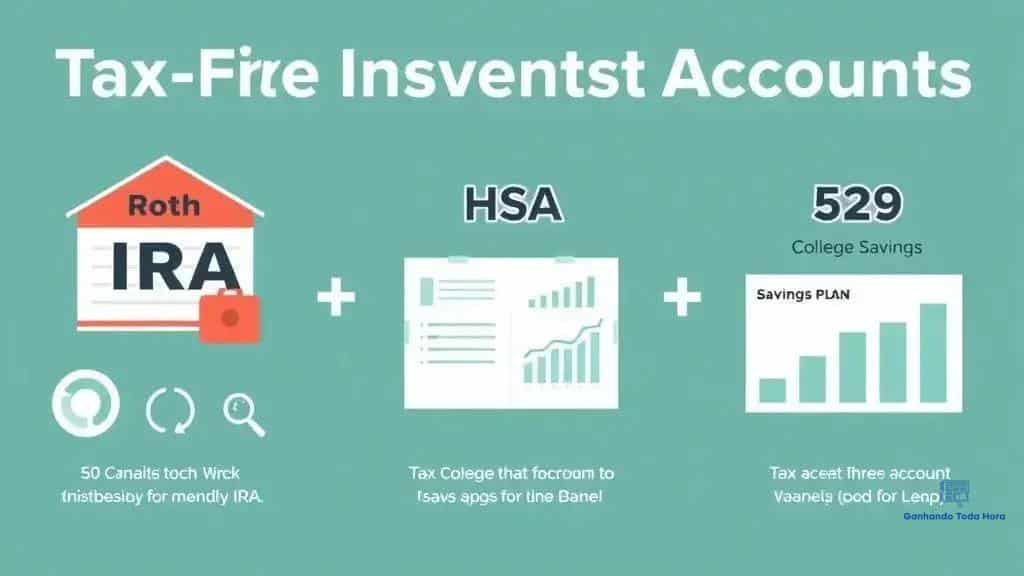Tax-free investments: secrets to growing your wealth

Anúncios
Tax-free investments allow you to grow wealth without being taxed on earnings, including accounts like Roth IRAs and HSAs, but require careful management to avoid pitfalls such as contribution limits and withdrawal rules.
Tax-free investments might sound like a financial dream, but they can be a reality for many savvy investors. Have you ever wondered how you can grow your wealth without the tax burden? Let’s explore the ins and outs of these opportunities.
Anúncios
Understanding tax-free investments
Understanding tax-free investments is crucial for anyone looking to grow their wealth efficiently. These types of investments allow you to avoid paying taxes on your earnings, which can ultimately lead to greater financial gains over time.
What Are Tax-Free Investments?
Tax-free investments include various financial options that provide benefits, such as not paying taxes on capital gains or income generated. These investments can come in many forms, each tailored to different financial goals and strategies.
- Roth IRAs: Contributions are made with after-tax dollars, allowing for tax-free withdrawals in retirement.
- Health Savings Accounts (HSAs): Funds can be used for qualified medical expenses without tax implications.
- Municipal Bonds: Interest earned is often exempt from federal taxes, making them attractive to higher tax brackets.
Investing in these accounts requires some planning, but the benefits can make a significant impact on your financial future. A notable aspect is that as long as you adhere to the rules of these accounts, the growth remains untaxed.
Why Choose Tax-Free Investments?
One of the primary reasons people opt for tax-free investments is the potential for higher net returns. Without the burden of taxes deducting from your earnings, you can reinvest more of your income. This compounding effect over the years can create substantial wealth over time.
Anúncios
Another key benefit is flexibility. Many tax-free accounts allow you to choose how you invest your contributions, whether through stocks, bonds, or mutual funds, allowing personalization of your portfolio according to your risk comfort and financial objectives.
In conclusion, understanding the ins and outs of tax-free investments can help you make informed decisions, enabling you to maximize your returns while minimizing your tax obligations. With various options available, choosing the right accounts tailored to your lifestyle and goals is essential for long-term success.
Types of tax-free investment accounts

Exploring the different types of tax-free investment accounts can help you choose the best options for your financial goals. Knowing which accounts allow you to grow your investments without tax implications is key to effective wealth management.
1. Roth IRA
A Roth IRA is a popular retirement account that allows you to contribute after-tax dollars. The beauty of this account is that all earnings and qualified withdrawals are tax-free in retirement. This means your money can grow without being taxed at all!
- No taxes on withdrawals in retirement.
- Income limits for contributions apply.
- Contributions are not tax-deductible but can provide tax-free earnings.
Due to these benefits, many investors use Roth IRAs to secure their financial future while enjoying the tax-free growth potential.
2. Health Savings Account (HSA)
A Health Savings Account is designed for individuals with high-deductible health plans. Contributions are made with pre-tax dollars, and withdrawals for eligible medical expenses are tax-free. This account not only provides health coverage options, but it also allows your investments to grow tax-free.
- Funds can be rolled over each year.
- Tax-free withdrawals for qualified medical needs.
- Excellent for saving for future healthcare costs.
By utilizing an HSA, you can manage your health expenses while also investing for future needs.
3. 529 College Savings Plan
The 529 College Savings Plan is a special account designed to help families save for education expenses. Contributions grow tax-free, and withdrawals for qualified education expenses are also exempt from federal taxes. This account can significantly reduce the financial burden of higher education.
- Contributions can be made by anyone.
- Funds can be used for college tuition and related expenses.
- State tax benefits may also apply.
This makes the 529 plan a useful tool for planning a child’s educational future.
Understanding these key types of tax-free investment accounts equips you with the knowledge to invest wisely. Whether focusing on retirement, health care, or education, each account serves distinct purposes while providing significant tax benefits.
Benefits of investing tax-free
Investing in tax-free accounts offers several advantages that can help maximize your financial gains. Understanding these benefits is essential for anyone looking to grow their wealth effectively.
1. Increased Returns
One of the primary benefits of tax-free investing is the potential for higher returns. Without taxes eating into your profits, every dollar earned can be reinvested and help compound your wealth over time. This allows your investments to grow more efficiently compared to taxable accounts.
- Compounding effect: The longer your money remains invested, the more it can grow.
- No capital gains tax: You keep all the profits made when you sell assets.
- Tax-free withdrawals: Enjoy the full benefit of your investment without deductions.
This means that your money can really work for you, leading to potentially substantial gains in the long run.
2. Financial Flexibility
Another advantage of investing through tax-free accounts is enhanced financial flexibility. Many of these accounts allow you to access your funds under specific conditions without incurring taxes. For instance, in a Roth IRA, you can withdraw contributions at any time without taxes or penalties, allowing you to reposition your investments as needed or address emergencies without worrying about tax implications.
Furthermore, examples like Health Savings Accounts (HSAs) offer flexibility in managing both health expenses and investment growth, making it a versatile financial tool.
3. Tax Planning Opportunities
Utilizing tax-free investments can significantly improve your tax planning strategies. By maximizing contributions to tax-free accounts, you can lower your taxable income in retirement, ensuring you remain in a lower tax bracket. This can lead to reduced tax payments when withdrawing income from taxable sources.
- Retirement planning: Lower taxable income can help manage tax implications in retirement.
- Minimized tax liabilities: Strategically withdrawing funds can help manage overall tax burden.
- Long-term savings: Grow your investments tax-free while maintaining control over tax implications.
Recognizing these aspects of investing tax-free can help you build a robust investment strategy that works in your favor.
Strategies for maximizing tax-free benefits

Maximizing benefits from tax-free investments requires careful planning and smart strategies. Implementing these techniques can significantly boost your financial growth.
1. Contribute Early and Regularly
One important strategy is to start contributing to your tax-free accounts as early as possible. By contributing early, you allow your investments more time to grow. Setting up automatic contributions can make this easier. This ensures you consistently add to your accounts and take full advantage of the compounding effect.
- Establish a routine: Set monthly contributions to keep up with your investment goals.
- Take advantage of employer matches: If your employer offers matching contributions, be sure to maximize this benefit.
- Utilize catch-up contributions: If you’re over 50, make additional contributions to boost your savings.
By regular contributions, you enhance the overall growth potential of your tax-free investments.
2. Diversify Your Investments
Diversification is another key strategy to maximize tax-free benefits. By spreading your investments across various asset classes, you can better manage risks and enhance returns. This could include a mix of stocks, bonds, and even real estate investments, depending on your risk tolerance and financial goals.
Different assets tend to perform differently during various market conditions. By maintaining a well-diversified portfolio, you are more likely to achieve steady growth over time.
3. Utilize Tax-Free Opportunities Wisely
Another essential strategy is to understand and utilize the various tax-free opportunities offered by your investment accounts. For instance, learn about all the rules governing your Roth IRA, including how to withdraw funds without taxes or penalties.
- Know your withdrawal options: Familiarize yourself with which funds can be withdrawn tax-free.
- Use Health Savings Accounts effectively: Make medical payments directly from your HSA to take advantage of tax-free distributions.
- Consider qualified higher education expenses: Use a 529 plan for tax-free withdrawals when paying for college.
By implementing these strategies, you can ensure that you are maximizing the benefits of your tax-free investments and creating a brighter financial future.
Common pitfalls to avoid in tax-free investments
While tax-free investments can provide excellent benefits, several common pitfalls can hinder your financial success. Being aware of these challenges can help you navigate your investment strategy more effectively.
1. Ignoring Contribution Limits
Each type of tax-free account has specific contribution limits. Overcontributing can lead to penalties or taxes that could negate the benefits of your investments. It’s crucial to understand these limits and plan your contributions accordingly.
- Roth IRA: The limit changes annually, so stay updated.
- HSA: Limits differ based on whether you have individual or family coverage.
- 529 Plan: Contribution limits vary by state.
Failing to monitor these limits can result in unintended tax implications, reducing your overall returns.
2. Neglecting Account Management
Regular management of your tax-free investment accounts is essential. This means reviewing your portfolio, rebalancing as needed, and keeping track of changes in tax laws that may affect your strategy. Neglect can lead to missed opportunities for growth or unnecessary tax liabilities.
It’s important to make informed decisions and remain actively involved in your investments. Set reminders to regularly assess your accounts.
3. Overlooking Withdrawal Rules
Each tax-free account has specific rules regarding withdrawals. For example, while you can withdraw contributions from a Roth IRA without penalty, earnings come with restrictions. Ignoring these rules can result in taxes or penalties that reduce your overall returns.
- Qualified distributions: Understand what qualifies for tax-free withdrawal.
- Timing: Some accounts require you to wait until you reach a certain age.
- Use on qualified expenses: Ensure withdrawals meet account guidelines.
Being well-informed about withdrawal rules helps you maximize the benefits of your investments while avoiding financial burdens.
4. Failure to Diversify
Pitting all your money into one type of investment can be risky. It’s essential to diversify your tax-free investments. This can help mitigate risks and enhance potential returns. Spreading your investments across different asset classes can balance your portfolio and reduce volatility.
By acknowledging these common pitfalls, you can strategize effectively and make the most of your tax-free investments. This awareness empowers you to avoid mistakes that could hinder your financial success.
In conclusion, understanding tax-free investments can significantly enhance your financial strategy. By avoiding common pitfalls and implementing effective strategies, you can maximize the benefits of these accounts. Starting early, diversifying your portfolio, and staying informed about regulations will pave the way for financial success. Always remember the importance of careful planning and regular account management to reap the full rewards of your tax-free investments.
FAQ – Frequently Asked Questions about Tax-Free Investments
What are tax-free investments?
Tax-free investments are accounts that allow you to earn income without having to pay taxes on your gains, such as Roth IRAs or Health Savings Accounts.
How can I maximize my tax-free investment benefits?
You can maximize your benefits by contributing early, diversifying your portfolio, and regularly reviewing your accounts for optimal management.
What are some common pitfalls to avoid?
Some pitfalls include ignoring contribution limits, neglecting account management, overlooking withdrawal rules, and failing to diversify your investments.
Can I withdraw money from my tax-free accounts anytime?
Withdrawals depend on specific rules for each account. For example, you can withdraw contributions from a Roth IRA anytime, but earnings have restrictions.